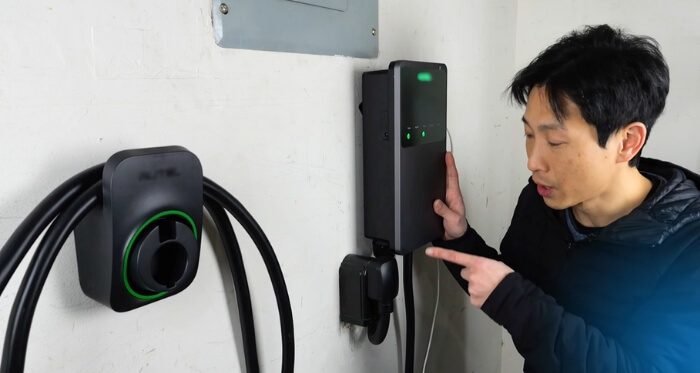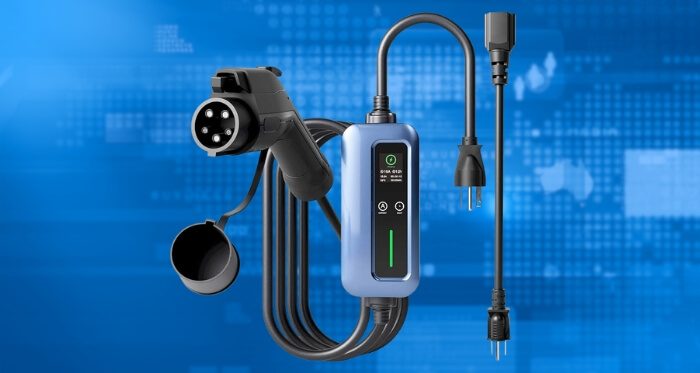The rise of EVs has made it essential to know the various aspects related to it. One of the basics of EVs is its charging method. Owners, buyers, investors, and anyone related to the sector should have some form of knowledge of it. A common question for EV communities is ‘What is a level 2 EV charger?’. We will provide a glimpse of the topic here.
It is an AC type of EV charger. Which is faster than the level 1 charger and operates at 240 volts, while the level 1 charger operates at 120 volts. Higher voltage makes it faster than a level 1 charger. Also, it has a higher charging rate than a level 1 charger.
Exciting news for EV owners in Bangladesh. The Amiti21 is a level 2 charging station provided by Crackplatoon CSL in Bangladesh. Here, we’ll explore all the factors related to the level 2 charger, the key points, and features. So, to learn more, continue reading to the end.
What is an EV Charger?
One of the most essential components of an EV charging station is an EV charger. It supplies the necessary electrical power to recharge the battery of an EV. A device to complete the charging process.
Typically classified into three different types. With a variety of charging speeds, connectors, and charging methods. They can be installed in homes, offices, parking places, or nearby typical public highways based on their types.
The Electric Vehicle Charging Guideline for Bangladesh classifies these into two main categories. Private and public charging stations, based on the location of the EV charger. While private stations can implement type 1 and type 2 chargers, for the public type 2 and DC chargers are recommended.
Crackplatoon CSL EV charging is one of the leading service providers for EV charging stations in Bangladesh. They have both types of charging stations for users or investors in this region.
What is a Level 2 EV Charger?
Based on the charging method EV chargers are classified into two categories. The AC and DC charging. While AC charging is typically slower than the DC charging method. AC charging also has two different variants, level 1 and level 2 charging.

So, while asking what is a level 2 charger, knowing the above category is important. The level 2 charger works at 240 volts, faster than the level 1 charger. The working process is Alternative Current. Here are some key characteristics that a level 2 charger has.
Voltage and Amperage
They operate at 240 volts AC and have various amperage options, typically ranging from 16 to 80 amps. Their charging capacity ranges between 7-11 kWh. Makes them suitable for home and office EV charging stations.
Charging Speed
Their charging speed is relatively faster than the level 1 charger. Which increases significant charging times. The exact charging speed varies depending on the charger’s power output and the EV’s battery capacity.
For instance, the 11kWh level 2 charger will take around 3 hours for an EV that has a battery capacity of 30 kWh. EV battery and EV charger both capacity determines the charging speed.
Installation Requirements
Installing these chargers typically requires a dedicated electrical circuit and, in some cases, the services of a licensed electrician. This ensures safe and reliable charging and may involve additional installation costs.
In Bangladesh, a permission procedure is required to build a level 2 EV charging station. Investors who are planning their EV business need to know about this process. There is a permission process required to install an EV charging station in Bangladesh.
Connector Types
They come with different connector types to match the EV’s charging port. Common connector types include J1772 (Type 1) and Type 2. The Crackplatoon EV level 2 model is compatible with these connectors.
Applications
These chargers are suitable for a wide range of applications. They are commonly used in residential settings, where they provide a convenient and faster EV charging solution for homeowners.
Also, they can be found in commercial locations, such as workplaces and retail centers, as well as in public charging networks, making them versatile and accessible for EV owners.
These are the basic characteristics of a level 2 charger, and knowing these will help you to proceed with charging your EV with these chargers.
How Does a Level 2 EV Charger Work?
The working procedure is very easy and simple to understand. For EV owners and drivers, it is necessary to understand these processes. So that they can utilize efficient and proper charging processes. Here is a step-by-step guide on how Level 2 EV chargers function.

Step 1:Power Supply and Connection
Their voltage requirement is 240, and typical charging capacity ranges between 7-11 kWh. To initiate charging the EV owners or drivers have to connect the charger’s cable to their vehicle’s port. Make sure a secure and proper connection is made for smooth charging.
Step 2:Communication and Authentication
Many of them have communication capabilities. So, they can authenticate the EV and the charger to ensure compatibility and safety. Also, some of the stations have a smart app feature, which can verify the user’s access and payment information.
Step 3: Charging Initiation
Once a secure connection is established and authentication is confirmed, it begins supplying electrical energy to the EV’s battery. The EV charger controls the flow of electricity to ensure safe and efficient charging.
Step 4: Monitoring and Control
Throughout the charging process, the Level 2 EV charger monitors various parameters, such as voltage, current, and battery temperature. It adjusts the charging rate as needed to prevent overheating and maximize battery life.
These are the general steps for charging with a level 2 charger, with these steps, you can have a smooth EV charging experience.
The Benefits of Level 2 Charger
These offer significant advantages for EV owners, improving the charging experience in various ways. These chargers represent a considerable upgrade from the basic Level 1 EV charger. Here are some key benefits

Faster Charging Speed
They typically provide power at a higher rate, significantly reducing charging time compared to Level 1 chargers. This allows EV owners to quickly recharge their vehicles, making them ready for use sooner.
Increased Convenience
While installed at home, EV owners can enjoy the convenience of charging their vehicles overnight. Ensuring a fully charged vehicle each morning, eliminating the need for frequent use of public EV charging stations.
Enhanced Battery Health
They are more efficient in managing the charging process, which can help maintain battery health. Proper charging techniques can extend the lifespan of the vehicle’s battery.
Higher Resale Value
Installing at home can potentially increase the property’s value. Homebuyers with EVs often see this as an attractive feature, making the property more appealing.
Greater Accessibility
As they are becoming more common in public spaces, offering greater accessibility for EV drivers. This widespread availability makes long-distance travel more feasible for EV owners.
Environmental Impact
By enabling faster and more efficient charging, Level 2 chargers support the use of electric vehicles. This contributes to reduced emissions and a smaller carbon footprint, benefiting the environment.
The Future of Level 2 Chargers
EV charging technology is rapidly evolving, offering new solutions and challenges. Level 2 chargers, in particular, stand at the forefront of this transformation. This discussion will dive into various aspects of Level 2 EV chargers, providing a general knowledge of their future potential and implications.

Overview
They are an intermediary step between basic and high-speed charging solutions. While provides a faster charging rate than Level 1 EV chargers, making them suitable for home and public use. Unlike Level 3 chargers, they do not require heavy infrastructure, thus offering a practical solution for most EV users.
Integration with Renewable Energy
It is expected to integrate smoothly with renewable energy sources in the future. This integration will enable a more sustainable and efficient charging process, reducing reliance on traditional power grids. As renewable energy becomes more prevalent, Level 2 chargers will play a critical role in facilitating green energy use in EVs.
Smart Charging Features
Advancements in smart technology will greatly enhance Level 2 charger capabilities. These chargers will likely incorporate features like demand response, user scheduling, and real-time data analysis. Such smart features will optimize charging times and costs, improving the overall user experience.
Global Market Expansion
The global expansion of Level 2 chargers is inevitable, given the rising demand for EVs. This expansion includes diverse markets, such as EV charger suppliers in Bangladesh, contributing to a more connected and efficient global charging network. This will ensure that EV charging solutions are accessible in both developed and developing countries.
Regulatory Developments
Regulatory frameworks and standardization are key to the widespread adoption of Level 2 chargers. Governments and industry bodies are working to establish universal standards and safety protocols. These developments will ensure compatibility across different EV models and charging networks, enhancing user convenience and safety.
Innovations
Continuous innovation is shaping the future of these chargers. Researchers are exploring new materials and designs to increase charging efficiency and reduce costs. Such innovations will make Level 2 EV chargers more appealing to both consumers and businesses, accelerating the transition to electric vehicles.
So, the future of Level 2 chargers is intertwined with the broader evolution of electric vehicles and sustainable energy. As technology advances, these chargers will become more integrated, intelligent, and accessible.
Final Thought
While inquiring about the definition of a level 2 EV charger, we have surfed the EV charger itself. Then we explored the characteristics of level 2, its voltage, charging speed, installation requirements, and connector types. This information will help you to learn ‘What is a level 2 EV charger?’
For Bangladeshi EV users, we offered the service of Crackplatoon CSL. While they have EV charging stations that meet the needs of the EV users. The AMiti21 model is a level 2 charger.
The working process of the level 2 EV charger, and the benefits and the future of the EV charger were briefly described in our conversations. So, when choosing a level 2 EV charger these conditions will benefit you effectively.
